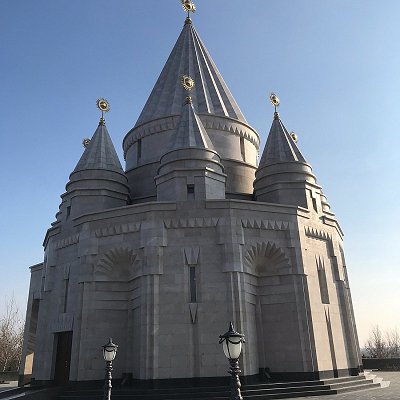
Like us on Facebook
PLACE NAMES



|
| Armavir |
 |
|
Armavir is a town and urban municipal community located in the west of Armenia serving as the administrative centre of Armavir Province. It was founded in 1931 by the government of the Armenian Soviet Socialist Republic. As of the 2011 census, the population of the town is 29,319, down from 46,900 as reported in the 1989 census. Currently, the town has a population of 65,515 as per the 2023 official estimate. Currently, Armavir is the seat of the Diocese of Armavir of the Armenian Apostolic Church.
Founded in 1931 as Sardarapat, the town was known as Hoktemberyan (meaning the city of October) between 1935 and 1995, named in honor of the October Revolution. In 1992, the town was named Armavir by the government of independent Armenia, after the nearby ancient city of Armavir, that was founded in the 8th century BC by King Argishti I of Urartu, and became the capital of the Kingdom of Armenia under the Orontid dynasty in 331 BC.
The area of ancient Armavir has been inhabited since the 6th millennium BC. Various obsidian instruments, bronze objects and pottery have been found from that period. Armenian accounts held the city to have founded by King Aramais, a grandson of Hayk, around 1980 BC.
During the first half of the 8th century BC, King Argishti I of Urartu built a fortress in the area and named it Argishtikhinili. In 331 BC, when Armenia under the Orontid dynasty asserted its independence from the Achæmenid Empire, Armavir was chosen as the capital of Armenia. Slabs of clay have been found from the Achæmenid period written in the Elamite language concerning episodes of the Gilgamesh epic. Various inscriptions in Hellenistic Greek carved around the third century BC, have been found, including poetry from Hesiod, lines from Euripides, a list of Macedonian months, and names of Orontid Kings.
According to the 5th-century Armenian historian Movses Khorenatsi, Armavir was the first capital of the Kingdom of Armenia (although, from a geographical standpoint, the first capital of Armenia was Van). Movses' history preserves a tradition that when King Valarsace the Parthian settled in Armavir (ca. 149 BC), he built a temple there and asked prince aspet (knight) Smbat of the Bagratuni dynasty to give up his religion and worship idols. But Smbat refused to comply. Movses also relates that when King Tigranes II (whom he places on the throne from 90 to 36 BC), in order to take revenge on Queen Cleopatra of Egypt, sent an expedition to Palestine, he carried a great number of Jews into captivity, and settled them in Armavir and in Vardges. Movses goes on to state that later Jews were transferred from Armavir to Yervandashat, and under King Artashes I, were again transferred into the new capital Artashat. When King Sapor II of Persia invaded Armenia (360-370), he led away from Artashat 30,000 Armenian and 9,000 Jewish families, the latter brought by King Tigranes from Judea, and then completely destroyed the city.
In 591 during the reign of emperor Maurice, Armavir (then called Armaouira) and much of Armenia came under Roman administration after the Romans defeated the Sassanid Persian Empire at the battle of the Blarathon.
During Antiquity, Armavir was taken by the Seleucids, Parthians, Roman Empire, Sassanids and Byzantine Empire before it was taken over by the Arabs in 645. By the decision of the Soviet government, the settlement of Armavir was founded as Sardarabat on 26 July 1931, only 8 km north of the ancient city of Armavir, to become the regional centre of the Hoktemberyan raion created earlier in 1930 (known as Ghurdughuli raion until 1935). It was originally founded as a railway station connecting Yerevan with Leninakan (Gyumri). The first major urban plan of the town was introduced by architect Alexander Tamanian.
In 1935, the name of the settlement was changed from Sardarabat to Hoktemberyan in honor of the 1917 October Revolution. At the beginning, it was home to Armenian families who migrated from Javakheti, Shirak and Zangezur. During the 1940s, many Yazidis and Kurds from the nearby villages have also settled in Hoktemberyan. With the rapid development of the settlement as an industrial hub, Hoktemberyan was given the status of a town in 1947.
The population of the town was further increased in the 1950s and 1960s upon the arrival of repatriated Armenian families from Iran, Syria and Lebanon. In 1966, the Armavir branch of the Yerevan Brandy Company was opened. In 1967, Hokberyan became a city of republican subordination.
Following the independence of Armenia in 1991, Hoktemberyan was renamed Armavir on 7 November 1995, to become the provincial centre of the newly formed Armavir Province, as per the 1995 administrative reforms of Armenia.
|
 Feel free to Email me any additions or corrections Feel free to Email me any additions or corrections
LINKS AVAILABLE TO YOUR SITE
| |





